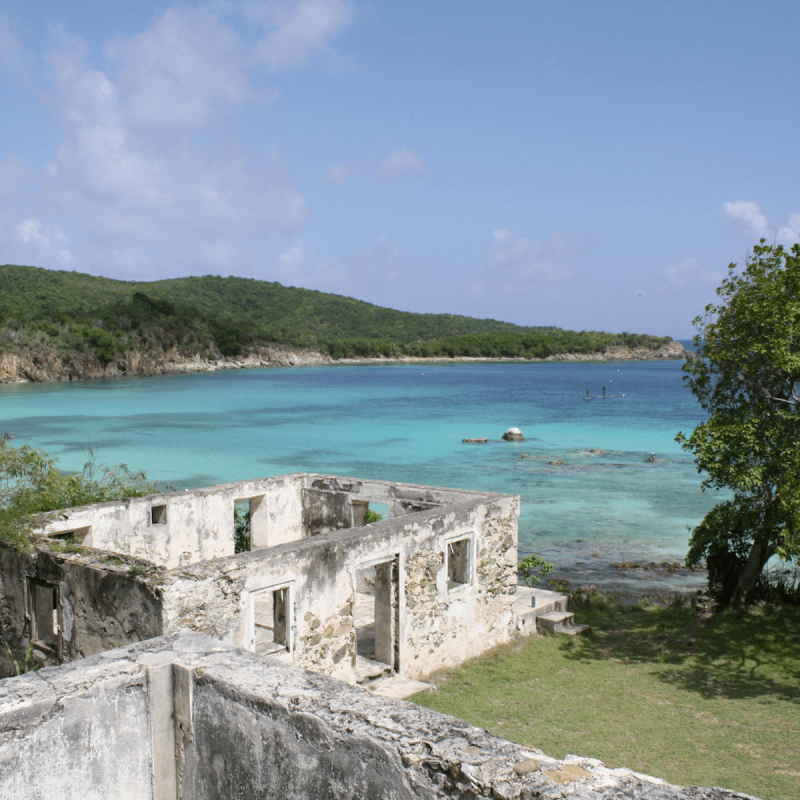
Hiking on St. John is a great way to enjoy a vacation in a remote, tropical paradise. Virgin Islands National Park protects a unique destination where you can experience history and see ruins left mostly untouched for more than 100 years. You can hike in the morning, enjoy amazing beaches in the afternoon, and experience great food and music throughout the night.
Videos by TravelAwaits
As a survivalist, I thoroughly enjoy spending time in nature. I have hiked most of the 30 trails that crisscross St. John and I have spent time on nearly every corner of the island. These are the 10 hikes that I enjoyed the most during my time on St. John.
If you’re heading to any of the Virgin Islands, make sure to check out our picks for Virgin Island family resorts.

1. Salt Pond Bay Trail
Length: 0.25 Miles
Difficulty: Easy
While this is not technically a hiking trail, it is a trail from the road where you park down to Salt Pond Bay Beach, which you must cross to reach the next two trails on the list. This uncrowded beach is beautiful and a great place to snorkel. I recommend planning a day at this beach. Rest, snorkel, have lunch, ignore the time, and hike the nearby trails.

2. Ram Head Trail
Length: 0.9 Miles
Difficulty: Moderate
This trail leads to the rocky cliffs that make up the southeastern tip of the island. This area has been battered by the ocean over the years and has the oldest rock on the island. The view of the ocean is a dramatic 270 degrees. Along the trail, you will pass Blue Cobblestone Beach which has unique cobblestones instead of sand.
There is no shade on this hike and the trail has loose rock in places, so take care, especially at night. If you wander off the trail, watch for the cacti. I know someone that had a cactus go through the sole of her shoe! It is best to hike in the early morning or late afternoon.
Pro Tip: One of the most dramatic times is at night by the light of the Moon, but again, keep a close eye on your footing!

3. Drunk Bay Trail
Length: 0.25 Miles
Difficulty: Easy
This trail leads from Salt Pond Bay, past the large Salt Pond to Drunk Bay on the west coast of the island. The differences between these two bays are dramatic. Salt Pond’s fine sand is a contrast to Drunk Bay’s cobblestones. Hikers often arrange the various stones found in Drunk Bay to make stick figures or spell out words. Some are quite funny!

4. Lameshur Bay Trail
Length: 1.5 Miles
Difficulty: Moderate
If you drive past the Salt Pond Bay Trailhead, you will eventually arrive at the road’s end at Little Lameshur Bay and the Lameshur Bay Trailhead. You will likely need a Jeep, as the road gets rough. This is an advantage because it makes it harder for most tourists to get to.
The white sand beach at Lameshur Bay is great for snorkeling and relaxing. Since it is so remote and hard to get to, there are seldom many visitors. The beautiful ruins of Lameshur Bay Plantation are near the beach; you can park just behind the ruins near the trailhead.
The Lameshur Bay Trail winds through the national park and ends on the Reef Bay Trail near Petroglyph Trail. This is my favorite way to get to these two trails. At the end of the trail, you will see the ruins of the Reef Bay Estate great house.

5. Reef Bay Trail
Length: 2.1 Miles
Difficulty: Moderate
The start of this trail begins on Centerline Road and descends 937 feet down into the Reef Bay Valley, once a large sugar plantation before the 1860s. You can see various ruins and rock fences in an area that is now a grown-up tropical forest. There is a guided tour of this trail available with the National Park Service. With this option, a boat picks you up on the beach at Reef Bay so you don’t have to walk back up the steep trail.
My favorite way to hike this trail is to come in on the Lameshur Bay Trail. We often pack a lunch and eat on the beach near the Reef Bay Sugar Mill ruins. Here, you can imagine the ships in the 1800s coming in to pick up the sugar and rum from the mill before heading back out to sea.

6. Petroglyph Trail
Length: 0.23 Miles
Difficulty: Moderate
This trail extends off of Reef Bay Trail to a scenic waterfall and a pool area where you can see ancient petroglyphs thought to be left by the Tainos between the year 700 and 1400. This is a tranquil area where you can sit and wonder what the carvings in the rocks mean.

7. Peace Hill
Length: 500 Feet
Difficulty: Easy
This trail is more of a walk than a hike. I mention it here simply because of the amazing view that is unmatched. At the end of the trail, you will discover the ruins of some interesting plantation structures and a windmill. From the grassy area at the top, you can even see the British Virgin Islands in the distance nestled in the amazing blue water of the Caribbean.
Pro Tip: Some of the best photography opportunities on the Island can be found right here.
8. Brown Bay Trail
Length: 1.6 Miles
Difficulty: Moderate
This trail starts off East End Road about 1 mile east of Coral Bay. You can park just off the road at the trailhead. Near the beach at Brown Bay, you will find plenty of ruins to explore. The area around the ruins is overgrown with vegetation so you will have to explore off the trail somewhat to see them. The trail ends where it intersects with Johnny Horn Trail.
9. Johnny Horn Trail
Length: 1.8 Miles
Difficulty: Moderate
You can start this trail at the Moravian Church in Coral Bay, but I prefer to arrive via the Brown Bay Trail. From the Brown Bay Trail, go left up the hill for some great views from Base Hill. Turn right and it will take you to ruins on both sides of the trail near Watermelon Bay. There is also a short trail that leads up a hill to the Windy Hill Greathouse ruins and some great views of the bay. This trail ends at the beach on the Leinster Bay Trail.

10. Leinster Bay Trail
Length: 0.8 Miles
Difficulty: Moderate
If you come from Johnny Horn Trail, this trail starts at the beach on Watermelon Bay. It follows an old road along the shore to the Annaberg Historic Site on Leinster Bay. Near Watermelon Bay, there are a number of ruins to explore, along with an “unofficial” trail that makes a loop back up the hill to the Johnny Horn Trail, near the end of the Brown Bay Trail. I usually take this on my way back from Annaberg. The Annaberg Sugar Plantation is one of the best-preserved historic sites on St. John. If you don’t want to hike all the way from the Brown Bay Trail, you can drive and park at this site and hike down to Watermelon Bay.
Recommended Items For Your Hike
Here are some items I recommend packing or getting once you are in St. John. Keep in mind that cell service on St. John is spotty, especially on the south and east side of the Island. Your cell phone may work if you are up in higher elevations. On the southern trails, you will have no signal. If you plan to use any hiking apps, make sure to download them for offline use when you have Wi-Fi.
First Aid Kit
If you are injured or have a sudden medical emergency, it will take some time to get help since you may not have cell service. Keep an IFAK (Individual First Aid Kit) with you that includes a tourniquet just to be safe. Also, keep some aspirin in case someone develops chest pain while hiking.
Map
The best printed map I have found is the Trail Bandit guide to the hiking trails of St. John, which offers both digital and print options. You can likely find a print copy in some of the shops in Cruz Bay or Coral Bay. Ask around on the Island and someone will know for sure.
GPS
A handheld GPS unit is still great to have even with phones these days. Just set a waypoint at the trailhead when you leave so you can easily find your way back. While it is nearly impossible to get completely lost on St. John, as the island is small, you can mistakenly go in the wrong direction at a trail cross. Even though you will be on island time, you don’t want to miss your new friends at the bar.
Sunscreen
While this may seem obvious, if you don’t bring it with you, it is hard to find once you are out of Cruz Bay. It is also expensive on St. John. The Sun is much more intense on the island and the cool ocean breeze helps you forget that you are getting sunburned.
Hat
A wide-brimmed hat is very handy. It not only keeps the Sun out of your face, but it also helps in those intense Caribbean afternoon downpours. It will also help to keep some of the huge spider webs out of your face when you run into them on the trail.
Cooler Backpack
When me and my wife hike, one of us will carry a regular backpack and the other will carry a cooler backpack. It is nice to have cool water to drink and lunch on the trail or beach. Get one with reusable ice packs and just toss them in the freezer at your villa each night.
Water
Staying hydrated is important if you plan to do a lot of hiking. While there is medical care available on St. John, it is more so just to get you stable before they send you to St. Thomas. Drink more than you think you need and don’t wait until you get thirsty. Shoot for at least a gallon a day if you are hiking a lot. I like to pick up a case of bottled water on St. Thomas and carry extra with me in my cooler backpack each day.
